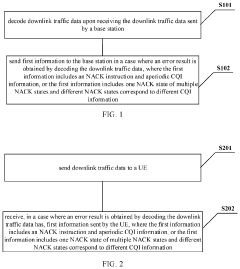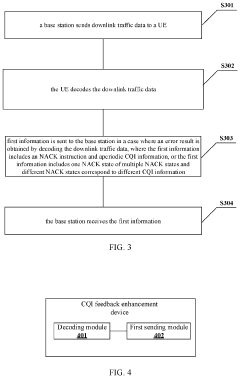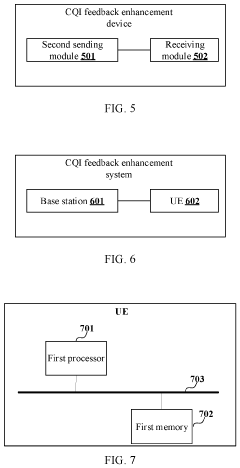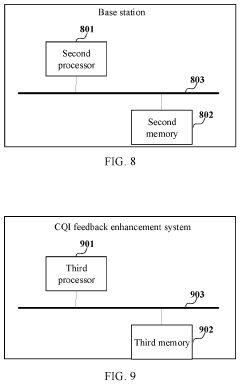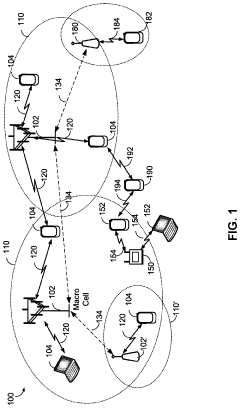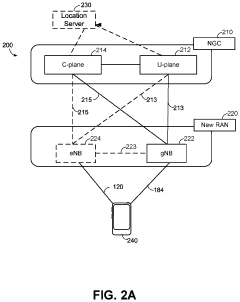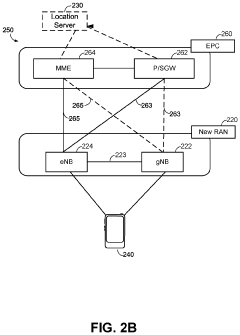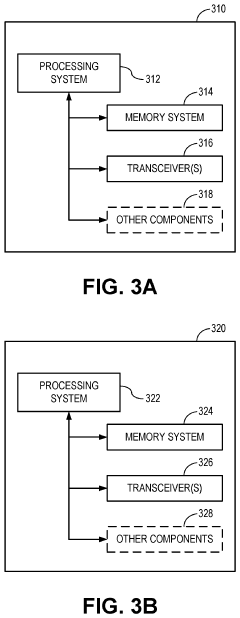What are the Implications of 5G UC for Enhanced Border Security?
JUL 18, 20259 MIN READ
Generate Your Research Report Instantly with AI Agent
Patsnap Eureka helps you evaluate technical feasibility & market potential.
5G UC Border Security Background and Objectives
The evolution of 5G technology has ushered in a new era of connectivity, with 5G UC (Ultra-Capacity) representing a significant leap forward in network capabilities. In the context of border security, 5G UC presents unprecedented opportunities to enhance surveillance, monitoring, and response mechanisms. This technological advancement comes at a critical time when nations worldwide face increasingly complex border security challenges, including illegal immigration, smuggling, and potential terrorist threats.
The primary objective of implementing 5G UC in border security is to create a more robust, efficient, and intelligent border management system. By leveraging the ultra-high bandwidth, low latency, and massive device connectivity offered by 5G UC, border agencies aim to significantly improve their situational awareness, decision-making processes, and operational effectiveness. This technology has the potential to transform traditional border security paradigms, enabling real-time data analysis, seamless integration of various sensors and devices, and enhanced coordination among different security agencies.
Historically, border security has relied on a combination of physical barriers, human patrols, and limited technological solutions. The introduction of 5G UC represents a pivotal moment in this field, promising to bridge existing gaps in coverage and response times. It allows for the deployment of advanced IoT devices, high-resolution cameras, and AI-powered analytics systems that can process vast amounts of data in real-time, providing border agents with actionable intelligence.
The development trajectory of 5G UC technology aligns closely with the evolving needs of border security. As threats become more sophisticated, the demand for more advanced, interconnected, and responsive security systems grows. 5G UC is expected to enable the creation of a digital fence that can detect, track, and respond to potential threats with unprecedented speed and accuracy. This includes the ability to monitor vast stretches of border areas using drones equipped with high-definition cameras and sensors, all connected and coordinated through the 5G UC network.
Furthermore, the implementation of 5G UC in border security is anticipated to facilitate better interagency cooperation and information sharing. By providing a robust communication infrastructure, it can enable seamless coordination between various law enforcement agencies, customs officials, and other relevant stakeholders. This improved collaboration is crucial for addressing the multifaceted challenges of modern border security, which often require a coordinated response from multiple agencies.
As we explore the implications of 5G UC for enhanced border security, it is essential to consider both the technological possibilities and the broader societal and ethical considerations. While the potential for improved security is significant, issues such as privacy, data protection, and the responsible use of AI in surveillance must be carefully addressed to ensure that the implementation of these advanced technologies aligns with democratic values and individual rights.
The primary objective of implementing 5G UC in border security is to create a more robust, efficient, and intelligent border management system. By leveraging the ultra-high bandwidth, low latency, and massive device connectivity offered by 5G UC, border agencies aim to significantly improve their situational awareness, decision-making processes, and operational effectiveness. This technology has the potential to transform traditional border security paradigms, enabling real-time data analysis, seamless integration of various sensors and devices, and enhanced coordination among different security agencies.
Historically, border security has relied on a combination of physical barriers, human patrols, and limited technological solutions. The introduction of 5G UC represents a pivotal moment in this field, promising to bridge existing gaps in coverage and response times. It allows for the deployment of advanced IoT devices, high-resolution cameras, and AI-powered analytics systems that can process vast amounts of data in real-time, providing border agents with actionable intelligence.
The development trajectory of 5G UC technology aligns closely with the evolving needs of border security. As threats become more sophisticated, the demand for more advanced, interconnected, and responsive security systems grows. 5G UC is expected to enable the creation of a digital fence that can detect, track, and respond to potential threats with unprecedented speed and accuracy. This includes the ability to monitor vast stretches of border areas using drones equipped with high-definition cameras and sensors, all connected and coordinated through the 5G UC network.
Furthermore, the implementation of 5G UC in border security is anticipated to facilitate better interagency cooperation and information sharing. By providing a robust communication infrastructure, it can enable seamless coordination between various law enforcement agencies, customs officials, and other relevant stakeholders. This improved collaboration is crucial for addressing the multifaceted challenges of modern border security, which often require a coordinated response from multiple agencies.
As we explore the implications of 5G UC for enhanced border security, it is essential to consider both the technological possibilities and the broader societal and ethical considerations. While the potential for improved security is significant, issues such as privacy, data protection, and the responsible use of AI in surveillance must be carefully addressed to ensure that the implementation of these advanced technologies aligns with democratic values and individual rights.
Market Analysis for 5G UC in Border Control
The market for 5G UC (Ultra-Reliable Low-Latency Communication) in border control is experiencing rapid growth and transformation. As nations worldwide prioritize enhanced border security measures, the demand for advanced technological solutions has surged. 5G UC offers unprecedented capabilities in real-time data transmission, remote sensing, and autonomous systems integration, making it a pivotal technology for modernizing border control operations.
The global market for 5G UC in border security is projected to expand significantly over the next decade. This growth is driven by increasing government investments in border protection, rising concerns over cross-border threats, and the need for more efficient and effective border management systems. The market encompasses a wide range of applications, including surveillance systems, unmanned aerial vehicles (UAVs), ground sensors, and command and control centers.
Key market segments within the 5G UC border control sector include perimeter security, intrusion detection, facial recognition, and remote monitoring systems. The perimeter security segment is expected to hold a substantial market share due to the critical need for continuous surveillance along extensive border areas. Intrusion detection systems enhanced by 5G UC capabilities are gaining traction for their ability to provide real-time alerts and reduce false alarms.
Geographically, North America and Europe are currently leading the market adoption of 5G UC for border control. These regions' advanced technological infrastructure and significant defense budgets contribute to their market dominance. However, Asia-Pacific is emerging as a rapidly growing market, driven by increasing border tensions and substantial investments in security technologies by countries like China and India.
The market landscape is characterized by a mix of established defense contractors, telecommunications companies, and innovative startups. Major players are focusing on developing integrated solutions that leverage 5G UC's low latency and high reliability to create comprehensive border security ecosystems. Partnerships between technology providers and government agencies are becoming increasingly common, fostering innovation and accelerating market growth.
Despite the promising outlook, the market faces challenges such as high implementation costs, concerns over data privacy and security, and the need for extensive infrastructure upgrades. Additionally, the complex regulatory environment surrounding border control technologies and 5G spectrum allocation poses potential barriers to market entry and expansion.
Looking ahead, the market for 5G UC in border control is poised for substantial growth. The integration of artificial intelligence and machine learning with 5G UC is expected to unlock new capabilities in predictive analytics and autonomous decision-making for border security systems. As countries continue to prioritize border protection and technological advancement, the demand for 5G UC solutions in this sector is likely to intensify, driving further innovation and market expansion.
The global market for 5G UC in border security is projected to expand significantly over the next decade. This growth is driven by increasing government investments in border protection, rising concerns over cross-border threats, and the need for more efficient and effective border management systems. The market encompasses a wide range of applications, including surveillance systems, unmanned aerial vehicles (UAVs), ground sensors, and command and control centers.
Key market segments within the 5G UC border control sector include perimeter security, intrusion detection, facial recognition, and remote monitoring systems. The perimeter security segment is expected to hold a substantial market share due to the critical need for continuous surveillance along extensive border areas. Intrusion detection systems enhanced by 5G UC capabilities are gaining traction for their ability to provide real-time alerts and reduce false alarms.
Geographically, North America and Europe are currently leading the market adoption of 5G UC for border control. These regions' advanced technological infrastructure and significant defense budgets contribute to their market dominance. However, Asia-Pacific is emerging as a rapidly growing market, driven by increasing border tensions and substantial investments in security technologies by countries like China and India.
The market landscape is characterized by a mix of established defense contractors, telecommunications companies, and innovative startups. Major players are focusing on developing integrated solutions that leverage 5G UC's low latency and high reliability to create comprehensive border security ecosystems. Partnerships between technology providers and government agencies are becoming increasingly common, fostering innovation and accelerating market growth.
Despite the promising outlook, the market faces challenges such as high implementation costs, concerns over data privacy and security, and the need for extensive infrastructure upgrades. Additionally, the complex regulatory environment surrounding border control technologies and 5G spectrum allocation poses potential barriers to market entry and expansion.
Looking ahead, the market for 5G UC in border control is poised for substantial growth. The integration of artificial intelligence and machine learning with 5G UC is expected to unlock new capabilities in predictive analytics and autonomous decision-making for border security systems. As countries continue to prioritize border protection and technological advancement, the demand for 5G UC solutions in this sector is likely to intensify, driving further innovation and market expansion.
Current 5G UC Border Security Challenges
The implementation of 5G UC (Ultra-Reliable Low-Latency Communication) in border security presents several significant challenges. One of the primary obstacles is the need for extensive infrastructure upgrades along border regions. Many border areas are remote and lack the necessary telecommunications infrastructure to support 5G UC networks, requiring substantial investments in hardware and connectivity.
Another challenge is the integration of 5G UC technology with existing border security systems. Legacy equipment and protocols may not be compatible with the new 5G UC standards, necessitating complex system overhauls and potential disruptions to ongoing security operations during the transition period.
The security of 5G UC networks themselves is a critical concern. As these networks become integral to border security operations, they become attractive targets for cyber attacks. Ensuring robust encryption, authentication, and intrusion detection mechanisms is essential but technically challenging, especially given the ultra-low latency requirements of 5G UC.
Spectrum allocation and management pose additional difficulties. 5G UC requires dedicated frequency bands to operate effectively, which may conflict with existing spectrum usage in border regions. Coordinating spectrum allocation across international borders adds another layer of complexity to this challenge.
The reliability and coverage of 5G UC in diverse border environments is also problematic. Border regions often include varied terrains such as mountains, deserts, and dense forests, each presenting unique challenges for signal propagation and network stability. Ensuring consistent, ultra-reliable coverage across these diverse landscapes is a significant technical hurdle.
Data privacy and sovereignty issues arise when implementing 5G UC for border security. The vast amount of sensitive data collected and transmitted through these networks raises concerns about data storage, processing, and sharing, especially in cross-border scenarios. Balancing national security needs with privacy rights and international data regulations is a complex challenge.
Interoperability between different countries' 5G UC border security systems is another critical issue. For effective cross-border cooperation, these systems need to communicate seamlessly, which requires standardization of protocols and data formats across different national implementations.
Lastly, the rapid evolution of 5G technology itself presents an ongoing challenge. As new advancements in 5G UC emerge, border security systems must be adaptable and upgradable to leverage these improvements, requiring continuous investment and technical expertise to stay current with the latest capabilities and security measures.
Another challenge is the integration of 5G UC technology with existing border security systems. Legacy equipment and protocols may not be compatible with the new 5G UC standards, necessitating complex system overhauls and potential disruptions to ongoing security operations during the transition period.
The security of 5G UC networks themselves is a critical concern. As these networks become integral to border security operations, they become attractive targets for cyber attacks. Ensuring robust encryption, authentication, and intrusion detection mechanisms is essential but technically challenging, especially given the ultra-low latency requirements of 5G UC.
Spectrum allocation and management pose additional difficulties. 5G UC requires dedicated frequency bands to operate effectively, which may conflict with existing spectrum usage in border regions. Coordinating spectrum allocation across international borders adds another layer of complexity to this challenge.
The reliability and coverage of 5G UC in diverse border environments is also problematic. Border regions often include varied terrains such as mountains, deserts, and dense forests, each presenting unique challenges for signal propagation and network stability. Ensuring consistent, ultra-reliable coverage across these diverse landscapes is a significant technical hurdle.
Data privacy and sovereignty issues arise when implementing 5G UC for border security. The vast amount of sensitive data collected and transmitted through these networks raises concerns about data storage, processing, and sharing, especially in cross-border scenarios. Balancing national security needs with privacy rights and international data regulations is a complex challenge.
Interoperability between different countries' 5G UC border security systems is another critical issue. For effective cross-border cooperation, these systems need to communicate seamlessly, which requires standardization of protocols and data formats across different national implementations.
Lastly, the rapid evolution of 5G technology itself presents an ongoing challenge. As new advancements in 5G UC emerge, border security systems must be adaptable and upgradable to leverage these improvements, requiring continuous investment and technical expertise to stay current with the latest capabilities and security measures.
Existing 5G UC Border Security Solutions
01 5G Ultra-Capacity Network Architecture
5G UC refers to an advanced network architecture that provides enhanced capacity and performance in 5G networks. It utilizes a combination of mid-band and high-band spectrum to deliver faster speeds, lower latency, and increased network capacity compared to standard 5G networks.- 5G Ultra-Capacity Network Architecture: 5G UC refers to an advanced network architecture that provides enhanced capacity and performance in 5G networks. It utilizes a combination of mid-band and high-band spectrum to deliver faster speeds, lower latency, and increased network capacity compared to standard 5G implementations.
- Spectrum Utilization in 5G UC: 5G Ultra-Capacity networks leverage a wide range of spectrum bands, including mid-band (2.5 GHz to 6 GHz) and millimeter-wave (mmWave) frequencies. This multi-band approach allows for improved coverage, capacity, and speed in urban and high-density areas.
- Advanced Antenna Technologies for 5G UC: 5G UC implementations often incorporate advanced antenna technologies such as Massive MIMO (Multiple-Input Multiple-Output) and beamforming. These technologies enable more efficient use of spectrum, improved signal quality, and increased network capacity.
- Network Slicing and Virtualization in 5G UC: 5G Ultra-Capacity networks utilize network slicing and virtualization techniques to create multiple virtual networks on a single physical infrastructure. This allows for optimized resource allocation and tailored services for different use cases and applications.
- Edge Computing Integration with 5G UC: 5G Ultra-Capacity networks often integrate edge computing capabilities to reduce latency and improve overall network performance. This integration enables real-time processing and data analysis closer to the end-user, supporting applications such as augmented reality, autonomous vehicles, and industrial IoT.
02 Spectrum Utilization in 5G UC
5G UC leverages a wide range of spectrum bands, including mid-band (2.5 GHz to 6 GHz) and millimeter-wave (mmWave) frequencies. This multi-band approach allows for improved coverage, capacity, and speed in urban and densely populated areas.Expand Specific Solutions03 Advanced Antenna Technologies for 5G UC
5G UC employs advanced antenna technologies such as Massive MIMO (Multiple-Input Multiple-Output) and beamforming. These technologies enable more efficient use of spectrum, improved signal quality, and increased network capacity to support a higher number of connected devices.Expand Specific Solutions04 Network Slicing and Virtualization in 5G UC
5G UC incorporates network slicing and virtualization techniques to create multiple virtual networks tailored for specific use cases and applications. This allows for optimized resource allocation and improved quality of service for different types of traffic and user requirements.Expand Specific Solutions05 Edge Computing Integration with 5G UC
5G UC networks are designed to work seamlessly with edge computing infrastructure, bringing computational resources closer to end-users and devices. This integration reduces latency, improves real-time processing capabilities, and enables new applications in areas such as augmented reality, autonomous vehicles, and industrial IoT.Expand Specific Solutions
Key Players in 5G UC Border Security
The 5G UC (Ultra Capacity) technology for enhanced border security is in its early development stage, with a growing market potential. The competitive landscape is characterized by major telecom players and technology giants investing in research and development. Companies like Ericsson, Nokia, Samsung, Qualcomm, and Huawei are at the forefront, leveraging their expertise in 5G infrastructure and network solutions. The market size is expected to expand significantly as governments worldwide prioritize border security. While the technology is still maturing, early adopters are already exploring its applications in surveillance, real-time data processing, and remote monitoring, indicating a promising future for 5G UC in border security systems.
Telefonaktiebolaget LM Ericsson
Technical Solution: Ericsson's 5G UC solution for enhanced border security focuses on creating a robust and scalable network infrastructure. The company's approach leverages its expertise in radio access networks (RAN) and core network technologies to provide ultra-reliable, low-latency communication for critical border control applications. Ericsson's 5G UC platform supports advanced network slicing, allowing dedicated virtual networks for different border security functions, such as surveillance, communication, and data analysis. The company's solution incorporates AI and machine learning capabilities for predictive maintenance of border security equipment and anomaly detection in sensor data[9]. Ericsson's 5G UC technology enables the deployment of autonomous patrol vehicles and drones for border surveillance, with real-time control and video streaming capabilities[10].
Strengths: Strong expertise in network infrastructure and proven track record in large-scale deployments. Weaknesses: May require partnerships for specialized border security applications and end-user devices.
Nokia Technologies Oy
Technical Solution: Nokia's 5G UC solution for border security focuses on creating a resilient and flexible network infrastructure. Their approach combines 5G New Radio (NR) technology with Multi-access Edge Computing (MEC) to enable ultra-low latency and high reliability for critical border control applications. Nokia's system supports advanced drone detection and counter-UAV measures, leveraging 5G's high bandwidth for real-time aerial surveillance[3]. The company's solution also incorporates AI-driven predictive maintenance for border security equipment, ensuring maximum uptime for critical systems. Nokia's 5G UC platform enables seamless integration of various sensors and IoT devices, creating a comprehensive situational awareness system for border agents[4].
Strengths: Strong focus on network reliability and integration with existing infrastructure. Weaknesses: May require significant investment in new hardware for full feature utilization.
Core 5G UC Border Security Innovations
Channel quality indicator feedback enhancement method, device and system, user equipment, and base station
PatentActiveUS11870568B2
Innovation
- The proposed method enhances CQI feedback by allowing the UE to send an NACK instruction along with aperiodic CQI information or multiple NACK states that correspond to different CQI levels, enabling the base station to determine retransmission parameters directly, thereby reducing latency and resource usage.
Collision handling
PatentActiveUS20220070885A1
Innovation
- A method for determining overlaps between uplink transmission channels, generating a combined uplink transmission payload, and transmitting it on either channel, allowing for efficient data transmission even when collisions occur, by prioritizing higher-priority channels like eURLLC over lower-priority channels like eMBB.
Cybersecurity Implications of 5G UC in Border Control
The integration of 5G Ultra-Capacity (UC) technology in border control systems presents significant cybersecurity implications that must be carefully considered. As border security becomes increasingly reliant on advanced communication networks, the adoption of 5G UC introduces both opportunities and challenges in maintaining robust cybersecurity measures.
One of the primary concerns is the expanded attack surface that 5G UC networks create. With increased connectivity and data transmission capabilities, there are more potential entry points for malicious actors to exploit. This necessitates a comprehensive reassessment of existing security protocols and the implementation of advanced threat detection and prevention mechanisms specifically designed for 5G environments.
The high-speed, low-latency nature of 5G UC also enables real-time data processing and analysis at the network edge. While this offers enhanced capabilities for border surveillance and rapid response, it also raises concerns about data privacy and protection. Ensuring the secure transmission and storage of sensitive information becomes paramount, requiring robust encryption methods and secure communication channels.
Another critical aspect is the potential for increased vulnerability to distributed denial-of-service (DDoS) attacks. The massive number of connected devices in a 5G UC network could be leveraged to launch large-scale attacks, potentially disrupting critical border control operations. Implementing advanced traffic monitoring and filtering systems becomes essential to mitigate this risk.
The virtualization and software-defined networking aspects of 5G UC introduce new challenges in network segmentation and access control. Proper configuration and management of network slices are crucial to prevent unauthorized access to sensitive border control systems and data. This requires a shift in security paradigms, moving towards a zero-trust architecture and continuous authentication mechanisms.
Furthermore, the reliance on a complex ecosystem of hardware and software components in 5G UC networks increases the importance of supply chain security. Ensuring the integrity and trustworthiness of all elements in the border control infrastructure becomes a critical consideration, necessitating rigorous vendor assessment and ongoing monitoring processes.
As 5G UC enables more sophisticated AI and machine learning applications in border security, the cybersecurity implications extend to the protection of these intelligent systems. Safeguarding against potential manipulation or exploitation of AI algorithms used in border control decision-making processes becomes a new frontier in cybersecurity efforts.
One of the primary concerns is the expanded attack surface that 5G UC networks create. With increased connectivity and data transmission capabilities, there are more potential entry points for malicious actors to exploit. This necessitates a comprehensive reassessment of existing security protocols and the implementation of advanced threat detection and prevention mechanisms specifically designed for 5G environments.
The high-speed, low-latency nature of 5G UC also enables real-time data processing and analysis at the network edge. While this offers enhanced capabilities for border surveillance and rapid response, it also raises concerns about data privacy and protection. Ensuring the secure transmission and storage of sensitive information becomes paramount, requiring robust encryption methods and secure communication channels.
Another critical aspect is the potential for increased vulnerability to distributed denial-of-service (DDoS) attacks. The massive number of connected devices in a 5G UC network could be leveraged to launch large-scale attacks, potentially disrupting critical border control operations. Implementing advanced traffic monitoring and filtering systems becomes essential to mitigate this risk.
The virtualization and software-defined networking aspects of 5G UC introduce new challenges in network segmentation and access control. Proper configuration and management of network slices are crucial to prevent unauthorized access to sensitive border control systems and data. This requires a shift in security paradigms, moving towards a zero-trust architecture and continuous authentication mechanisms.
Furthermore, the reliance on a complex ecosystem of hardware and software components in 5G UC networks increases the importance of supply chain security. Ensuring the integrity and trustworthiness of all elements in the border control infrastructure becomes a critical consideration, necessitating rigorous vendor assessment and ongoing monitoring processes.
As 5G UC enables more sophisticated AI and machine learning applications in border security, the cybersecurity implications extend to the protection of these intelligent systems. Safeguarding against potential manipulation or exploitation of AI algorithms used in border control decision-making processes becomes a new frontier in cybersecurity efforts.
International Cooperation for 5G UC Border Security
International cooperation is crucial for the effective implementation of 5G UC technology in border security. As nations increasingly recognize the potential of 5G UC to enhance border surveillance and management, collaborative efforts are becoming more prevalent.
One key area of cooperation is the development of common standards and protocols for 5G UC border security systems. This ensures interoperability between different countries' systems, facilitating seamless information sharing and coordinated responses to cross-border threats. Organizations such as the International Telecommunication Union (ITU) and the 3rd Generation Partnership Project (3GPP) play vital roles in establishing these global standards.
Joint research and development initiatives are another important aspect of international cooperation. Countries are pooling resources and expertise to accelerate the advancement of 5G UC technologies specifically tailored for border security applications. These collaborations often involve government agencies, academic institutions, and private sector companies from multiple nations, fostering innovation and knowledge exchange.
Cross-border pilot projects and field trials are becoming increasingly common, allowing countries to test and refine 5G UC border security solutions in real-world scenarios. These initiatives provide valuable insights into the practical challenges and benefits of implementing such technologies across diverse geographical and political landscapes.
Information sharing agreements between nations are essential for maximizing the potential of 5G UC in border security. These agreements facilitate the exchange of threat intelligence, best practices, and lessons learned, enabling countries to stay ahead of evolving security challenges. However, careful consideration must be given to data privacy and sovereignty concerns when establishing such agreements.
Capacity building and training programs are another crucial component of international cooperation. Developed nations with advanced 5G UC capabilities are increasingly offering assistance to countries with less developed infrastructure, helping to bridge the technological gap and ensure a more comprehensive global border security network.
Multilateral forums and conferences dedicated to 5G UC border security are becoming more frequent, providing platforms for policymakers, technologists, and security experts to discuss challenges, share experiences, and forge new partnerships. These events play a vital role in shaping the global discourse on the use of 5G UC for enhanced border security.
As 5G UC technology continues to evolve, international cooperation will remain essential for addressing emerging challenges and opportunities in border security. By working together, nations can leverage the full potential of 5G UC to create more secure and efficient border management systems while fostering global collaboration in the face of shared security concerns.
One key area of cooperation is the development of common standards and protocols for 5G UC border security systems. This ensures interoperability between different countries' systems, facilitating seamless information sharing and coordinated responses to cross-border threats. Organizations such as the International Telecommunication Union (ITU) and the 3rd Generation Partnership Project (3GPP) play vital roles in establishing these global standards.
Joint research and development initiatives are another important aspect of international cooperation. Countries are pooling resources and expertise to accelerate the advancement of 5G UC technologies specifically tailored for border security applications. These collaborations often involve government agencies, academic institutions, and private sector companies from multiple nations, fostering innovation and knowledge exchange.
Cross-border pilot projects and field trials are becoming increasingly common, allowing countries to test and refine 5G UC border security solutions in real-world scenarios. These initiatives provide valuable insights into the practical challenges and benefits of implementing such technologies across diverse geographical and political landscapes.
Information sharing agreements between nations are essential for maximizing the potential of 5G UC in border security. These agreements facilitate the exchange of threat intelligence, best practices, and lessons learned, enabling countries to stay ahead of evolving security challenges. However, careful consideration must be given to data privacy and sovereignty concerns when establishing such agreements.
Capacity building and training programs are another crucial component of international cooperation. Developed nations with advanced 5G UC capabilities are increasingly offering assistance to countries with less developed infrastructure, helping to bridge the technological gap and ensure a more comprehensive global border security network.
Multilateral forums and conferences dedicated to 5G UC border security are becoming more frequent, providing platforms for policymakers, technologists, and security experts to discuss challenges, share experiences, and forge new partnerships. These events play a vital role in shaping the global discourse on the use of 5G UC for enhanced border security.
As 5G UC technology continues to evolve, international cooperation will remain essential for addressing emerging challenges and opportunities in border security. By working together, nations can leverage the full potential of 5G UC to create more secure and efficient border management systems while fostering global collaboration in the face of shared security concerns.
Unlock deeper insights with Patsnap Eureka Quick Research — get a full tech report to explore trends and direct your research. Try now!
Generate Your Research Report Instantly with AI Agent
Supercharge your innovation with Patsnap Eureka AI Agent Platform!
